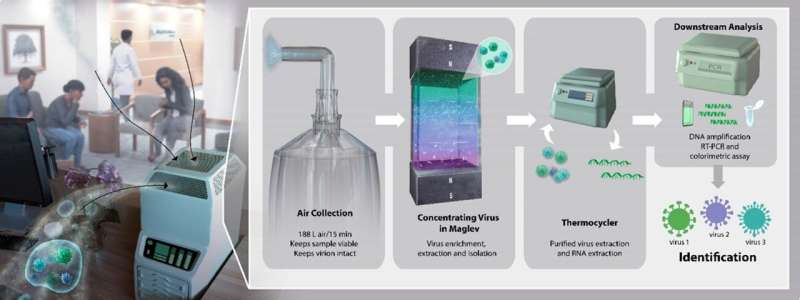This article has been reviewed according to Science X's editorial process and policies. Editors have highlighted the following attributes while ensuring the content's credibility:
fact-checked
peer-reviewed publication
trusted source
proofread
System that uses magnetic levitation enables early airborne virus detection

Researchers from Michigan State University and the University of British Columbia have invented a system that can quickly and inexpensively detect airborne viruses using the same technology that enables high-speed trains.
The team showed that a technique known as magnetic levitation can be used to easily collect and concentrate viruses from air to help prevent future outbreaks of respiratory disease. The researchers published their work in the journal ACS Nano.
"It's very important to have real-time management and real-time predictions in place for viruses," said Morteza Mahmoudi, an associate professor in the Department of Radiology and the Precision Health Program at MSU. "What we've developed is a system that could help us and other stakeholders get more information about the different types of viruses in the air we breathe."
"This could help identify that an environment is contaminated before a pandemic happens," said Sepideh Pakpour, an assistant professor of engineering who led the research team at the UBC Okanagan Campus.
In addition to serving as an early-warning system, the team's new technique also could help health officials and epidemiologists better track and trace exposure to viruses in public settings.
Pakpour and Mahmoudi first started this project applying magnetic levitation, or maglev, to respiratory viruses in 2018 with support from the Walsh Foundation and the New Frontiers in Research Fund. Almost half of lower respiratory tract infections are caused by viruses that people breathe in while indoors, the researchers wrote in their report.
But when the coronavirus pandemic started and as they learned that it was caused by an airborne virus, they knew they had to redouble their efforts. The team used a deactivated version of the coronavirus responsible for COVID-19 in their proof-of-concept report, along with H1N1 influenza and a virus that infects bacteria known as bacteriophage MS2.
The system first collects air samples, then injects the sample into a fluid where maglev separates viruses from other particles. The isolated and purified viral contents are then passed along to other standard analytical techniques for identification in a matter of minutes. The approach is so straightforward that it could be used by nonexperts in a variety of settings, such as clinics and airports, the researchers said.
The team is taking the first steps toward commercializing its technology while working to improve it at the same time.
Although downstream techniques can identify which viruses are in a sample, one of the team's future goals is refining the maglev step to distinguish between different viruses on its own. The researchers also are working to heighten their technique's sensitivity and detect viruses in air at lower concentrations.
Still, the team is excited by what it was able to accomplish in its initial work and by what it may enable other researchers to do.
"Using maglev for disease detection and purifying viruses is brand new, and it could open up applications in many different fields," Mahmoudi said. "This opens up a fundamentally new direction in analytical biochemistry."
A successful test flight for virus levitation
Magnetic levitation, as its name suggests, uses magnets to counteract the downward pull of gravity. Maglev trains float above their tracks and, unencumbered by that contact friction, can achieve speeds upwards of 200 miles per hour. While maglev trains have been around for decades, the use of magnetic levitation in biology is more recent.
For example, it was only within the last decade that Stanford researchers showed that living cells could be magnetically levitated in liquid mixtures or solutions. They then used the technique to show that various cell types—yeast, bacteria, healthy human cells and cancer cells—could be separated by their density.
More recently, Pakpour and Mahmoudi have collaborated to show that maglev can be applied to proteins in blood plasma to look for indicators of opioid use and multiple sclerosis. That convinced them maglev also should work with viruses.
"If you look at the structure of viruses, they're mostly proteins, and we knew we could levitate proteins," Pakpour said. "So I knew this should work, but I was still surprised when it did."
"It was very challenging, especially at the start," Mahmoudi said. "Conventional maglev is not capable of collecting submicron viruses, but we made several modifications and were able to fine-tune the system."
One of the challenges, for example, was that the liquids used in conventional maglev could damage or destroy viruses. The team had to find new solutions that had desirable magnetic properties and were compatible with their targets.
More information: Sepideh Pakpour et al, Magnetic Levitation System Isolates and Purifies Airborne Viruses, ACS Nano (2023). DOI: 10.1021/acsnano.3c01677
Journal information: ACS Nano
Provided by Michigan State University





















